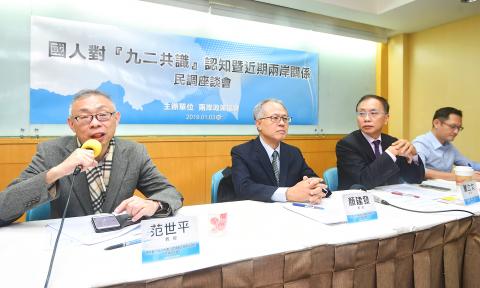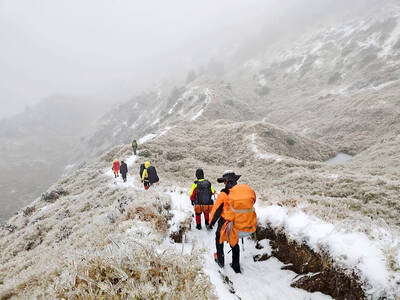More than 80 percent of Taiwanese would not accept the so-called “1992 consensus” if it meant supporting the “one China” principle, with “China” representing the People’s Republic of China (PRC), a Cross-Strait Policy Association poll showed yesterday.
The association published the poll one day after Chinese President Xi Jinping (習近平) gave a speech marking the 40th anniversary of the 1979 “Message to Compatriots in Taiwan.”
While promoting the “one county, two systems” formula, Xi said the “1992 consensus” means that “both sides of the Taiwan Strait belong to one China and will work jointly to seek national unification.”

Photo: Fang Pin-chao, Taipei Times
The “1992 consensus” — a term former Mainland Affairs Council chairman Su Chi (蘇起) admitted making up in 2000 — refers to a tacit understanding between the Chinese Nationalist Party (KMT) and the Chinese Communist Party that both sides acknowledge there is “one China,” with each side having its own interpretation of what “China” means.
Of the respondents, 84.1 percent said they would not accept the “1992 consensus” if it means supporting the idea of the PRC representing “China,” with no room left for the Republic of China (ROC), while 9 percent said they would.
Of those polled, 81.2 percent said they would not accept the “1992 consensus” if it promotes economic development at the cost of sovereignty and turns the ROC into a local government under Beijing’s control, the poll found.
Of the respondents, 54.2 percent supported reading the “1992 consensus” as meaning that each side has its own interpretation of what “China” means, with “one China” meaning the ROC.
When asked whether the “1992 consensus” is real, 45.1 percent of respondents said “no,” while 36.2 percent said “yes.”
Regarding the content of the “1992 consensus,” 55.5 percent said they did not have a clear understanding of it, while 40.2 percent said they did.
When asked to choose a definition of the “1992 consensus” that was closest to their understanding, 44.4 percent said that it means both sides of the Taiwan Strait are two different countries, while 20.9 percent said the two sides represent part of a yet-to-be-unified nation.
Of the respondents, 20.6 percent said it means each side claims to represent “China,” with 7.1 percent saying the ROC is a local government belonging to the PRC.
The poll also found that 62.6 percent of respondents approved of the government’s position respecting the historical fact that in 1992 a meeting occurred between the two institutions representing each side of the Taiwan Strait — Taiwan’s Straits Exchange Foundation and China’s Association for Relations Across the Taiwan Straits — while 28 percent disapproved.
Meanwhile, 64.1 percent of respondents said they did not agree with the statement that people do not need to know what the “1992 consensus” is as long as it brings economic benefits to Taiwan, while 91.7 said they believed that national security is as important as economic development.
The poll was conducted by telephone on Thursday and Friday last week, with 1,081 valid samples, a 2.98 point margin of error and a confidence level of 95 percent, the association said.

Trips for more than 100,000 international and domestic air travelers could be disrupted as China launches a military exercise around Taiwan today, Taiwan’s Civil Aviation Administration (CAA) said yesterday. The exercise could affect nearly 900 flights scheduled to enter the Taipei Flight Information Region (FIR) during the exercise window, it added. A notice issued by the Chinese Civil Aviation Administration showed there would be seven temporary zones around the Taiwan Strait which would be used for live-fire exercises, lasting from 8am to 6pm today. All aircraft are prohibited from entering during exercise, it says. Taipei FIR has 14 international air routes and

The Ministry of National Defense (MND) today released images of the military tracking China’s People's Liberation Army (PLA) movements during the latest round of Chinese drills around Taiwan. The PLA began "Justice Mission 2025" drills today, carrying out live-fire drills, simulated strikes on land and maritime targets, and exercises to blockade the nation's main ports. The exercises are to continue tomorrow, with the PLA announcing sea and air space restrictions for five zones around Taiwan for 10 hours starting from 8:30am. The ministry today released images showing a Chinese J-16 fighter jet tracked by a F-16V Block 20 jet and the

Snow fell on Yushan (Jade Mountain, 玉山) yesterday morning as a continental cold air mass sent temperatures below freezing on Taiwan’s tallest peak, the Central Weather Administration (CWA) said. Snowflakes were seen on Yushan’s north peak from 6:28am to 6:38am, but they did not fully cover the ground and no accumulation was recorded, the CWA said. As of 7:42am, the lowest temperature recorded across Taiwan was minus-5.5°C at Yushan’s Fengkou observatory and minus-4.7°C at the Yushan observatory, CWA data showed. On Hehuanshan (合歡山) in Nantou County, a low of 1.3°C was recorded at 6:39pm, when ice pellets fell at Songsyue Lodge (松雪樓), a

NO SHAME IN RETREAT: Hikers should consider turning back if the weather turns bad or if they do not have sufficient equipment, the Taroko park headquarters said Two people died of hypothermia over the weekend while hiking on Hsuehshan (雪山), prompting park authorities to remind hikers to bring proper equipment and consider their physical condition before setting out in the cold weather. Temperatures dropped over the weekend, bringing snow to high altitudes in Shei-pa National Park. One hiker, surnamed Lin (林), who on Friday was traveling with a group of six along the Hsuehshan west ridge trail, lost consciousness due to hypothermia and died, the Shei-pa National Park Headquarters said. On Saturday, another hiker, surnamed Tien (田), in a group of five on the southeast of the west